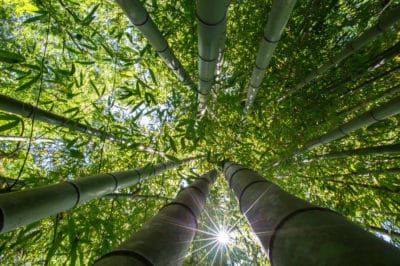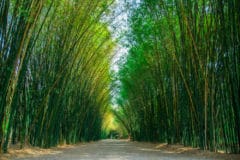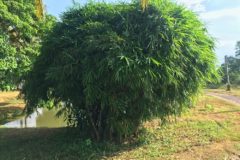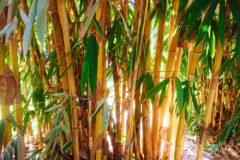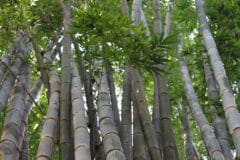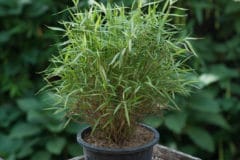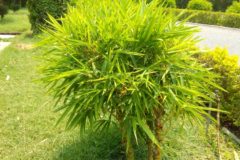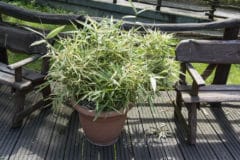Why Does Bamboo Grow So Fast?
If you remember bamboo is a form of grass, it’s easier to understand how long it can get. A bamboo bud has all the cells of an adult stem stacked one atop the other, like a column of coins. To grow, it need only fill the cells with water – stretching the cell lengthwise. Other grasses grow the same way, which is why you must mow your lawn on a regular basis.
How Fast Does Bamboo Grow?
The rate of bamboo growth is dependent on the species and variety. Plant maturity also makes a difference, as do do climate and growing conditions. Given the optimum climate and growing conditions, a mature clump of certain varieties of bamboo might grow 36 inches in one day. Bamboo is considered the fastest-growing plant in the world.
How Fast Does Bamboo Spread?
As with height, climate, growing conditions and plant maturity affect how fast a bamboo clump will spread. Bamboo puts on height in the spring. It spreads in summer and fall. At the end of a season, some varieties may have spread by as much as 15 feet. It spreads not by adding shoots to the stems but by throwing up more stems.
Do All Bamboo Varieties Grow Fast?
No. It depends on whether the variety is a running or clumping bamboo. Running bamboo grows much faster. Even within those two groups, there is considerable variation. For example, the Phyllostachys genus includes P. aurea, which might reach 20 feet, as well as P. edulis. The latter can be 70 feet tall at maturity. In some states, however, P. aurea is illegal because of its fast growth habit.
What is Running Bamboo?
Running bamboo got that name for two reasons. First, it spreads by rhizomes which grow sideways. This kind of rhizome is called leptomorph or monopodial. New culms spring up all along the length of the rhizome. Second, most running bamboos do grow quite fast – they literally run. Depending on the species, you can grow running bamboo from USDA zone 5 to the tropics.
What is Clumping Bamboo?
Unlike running bamboo, clumping bamboo grows new rhizomes from the base of an existing rhizome. This type is known as a pachymorph or sympodial rhizome. Each rhizome grows a little and then turns upward to form a new culm. The root mass of a clumping bamboo is much smaller compared to a running bamboo of the same age. Clumping types are also hardy to USDA zone 5.
How Can I Control Bamboo Growth?
Controlling bamboo growth takes several forms: containing, root-pruning and trenching (often used together). Growing bamboo in a container will keep it confined as long as you make sure it doesn’t grow out the drainage holes. A trench around the plant makes it easy to see rhizomes – which grow straight out. Finally, a sharp shovel will cut off rhizomes; use it regularly, as the bamboo will quickly get away from you.
What If I Cut Bamboo to the Ground?
Cutting bamboo down will make it shorter, but it doesn’t really affect the root mass. The roots will send out new shoots and quickly regrow. If you cut it down and cover with a heavy tarp or other impermeable covering, you might be able to starve out the roots to some extent. You’ll have to make sure it doesn’t send up new shoots around the edges of the covering.
How Can I Slow Down Bamboo Growth?
Withholding food and water will certainly slow down bamboo growth, as no plant can grow without those essentials. However, you will also have much less healthy plants. Root pruning doesn’t slow down the actual growth rate, it just keeps bamboo from spreading as fast as it would otherwise. It’s better to choose a variety that will meet your needs but that doesn’t have an extremely fast growth rate.
How Does Watering Affect Growth?
Generally speaking bamboo needs plenty of water for growth. Short the plants on water and they won’t grow as well. However, bamboo doesn’t like to stand in water – it isn’t a swamp plant. Excess water increases the risk of rot in the roots and crown of the plant. Obviously, sick plants won’t grow as well. A drip irrigation system will supply water for normal growth.
How Does Fertilizer Affect Growth?
Remember, bamboo is a grass. Just as your lawn responds to a dose of fertilizer, feeding bamboo will result in luxuriant growth. In good garden soils, you may be able to avoid fertilizing bamboo for some years, which can help control the growth rate. When you do fertilize, try using the minimum necessary and fertilize only once a year in spring or summer. Bamboo in poor soils will need fertilizer.
What Bamboos Have a Fast Growth Rate?
Running bamboos are nearly always faster-growing than clumping bamboos. Some, however, are notable for speed:
- Moso Bamboo – can grow 10 feet in about three weeks.
- Greenstripe Vivax – quickly grows to 45 feet tall.
- Golden Bamboo – mature height 35 feet; grows more slowly in cooler climates.
- Silverstripe Bamboo – one of the few clumping bamboos that grows fast.
- Pygmy Bamboo – only 12 inches tall, but still spreads very fast.
What Bamboos Have a Slow Growth Rate?
“Slow growth” is a relative term with bamboo. However, clumping bamboos do grow more slowly. Here are some possibilities:
- Chinese Mountain Bamboo – about 12 feet tall when mature; forms thick clumps.
- Umbrella Bamboo – similar to the above, but much more delicate in appearance.
- White Dragon – about eight feet, white striped leaves.
- Merlin – 15 to 25 feet at maturity; new shoots pale blue.
Is Bamboo Invasive?
Some species and varieties of running bamboo are considered highly invasive. The Phyllostachys group contains some of the fastest-growing plants in the world. In New York and Connecticut, P. aurea is illegal because of its invasive characteristics. Pygmy bamboo is another type that can be invasive; it is usually grown in containers for that reason. Any running bamboo that is not well-managed can become invasive.
How Does Bamboo Compare to Fast-Growing Shade Trees?
Most bamboos used for shade will grow faster than a tree. Fast -growing trees like the silver maple, box elder, cottonwoods and Lombardy Poplar can grow one to three feet in a year. Some bamboos can grow three or four times that fast. Shade trees typically are more dense and have a larger canopy than bamboo. Many fast-growing shade trees also litter badly, have weak crotches and a short lifespan.
What Are the Advantages of Fast Growth?
Obviously, speed is great when you want to cover up an unsightly structure, screen out the sight and noise of traffic or get some quick shade. Fast growth also helps the garden look more filled out in relatively short order. With bamboo, fast growth means you can quickly have an accent plant or a small, unique decorative spot in the garden.
What Are the Disadvantages of Fast Growth?
Fast growth in some plants means short maturity and weak branches. Neither of those is a problem with bamboo in most cases. However, the bamboos that grow fast require constant maintenance such as root pruning to keep them under control. There is also a risk that they will travel into a neighbor’s yard or take over some of your other plants.
How Does Climate Affect Bamboo Growth?
Bamboos originated in a variety of different climates. If you plant a bamboo outside its natural climate range, it may slow down growth. For example, a tropical bamboo planted in a cooler temperate climate will probably grow more slowly because it prefers warmer temperatures. Humidity may also play a role. Bamboo from humid areas planted in very dry climates may grow more slowly and suffer leaf browning or leaf drop.
